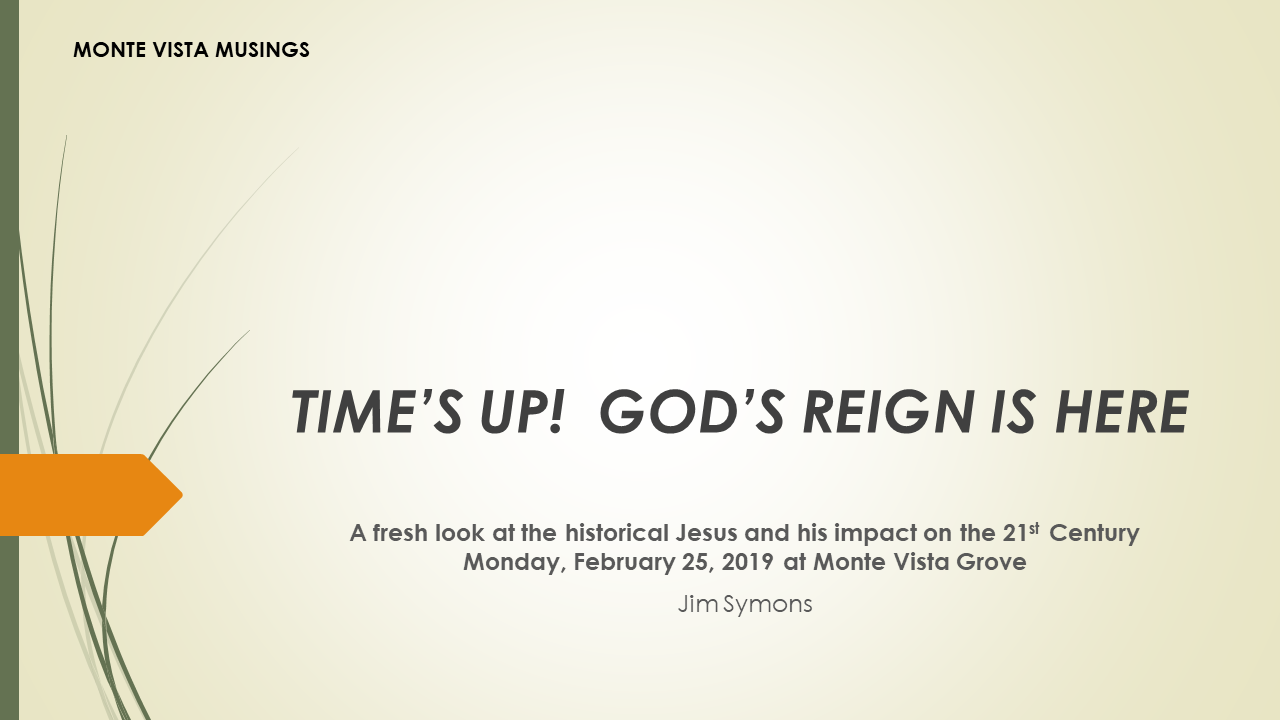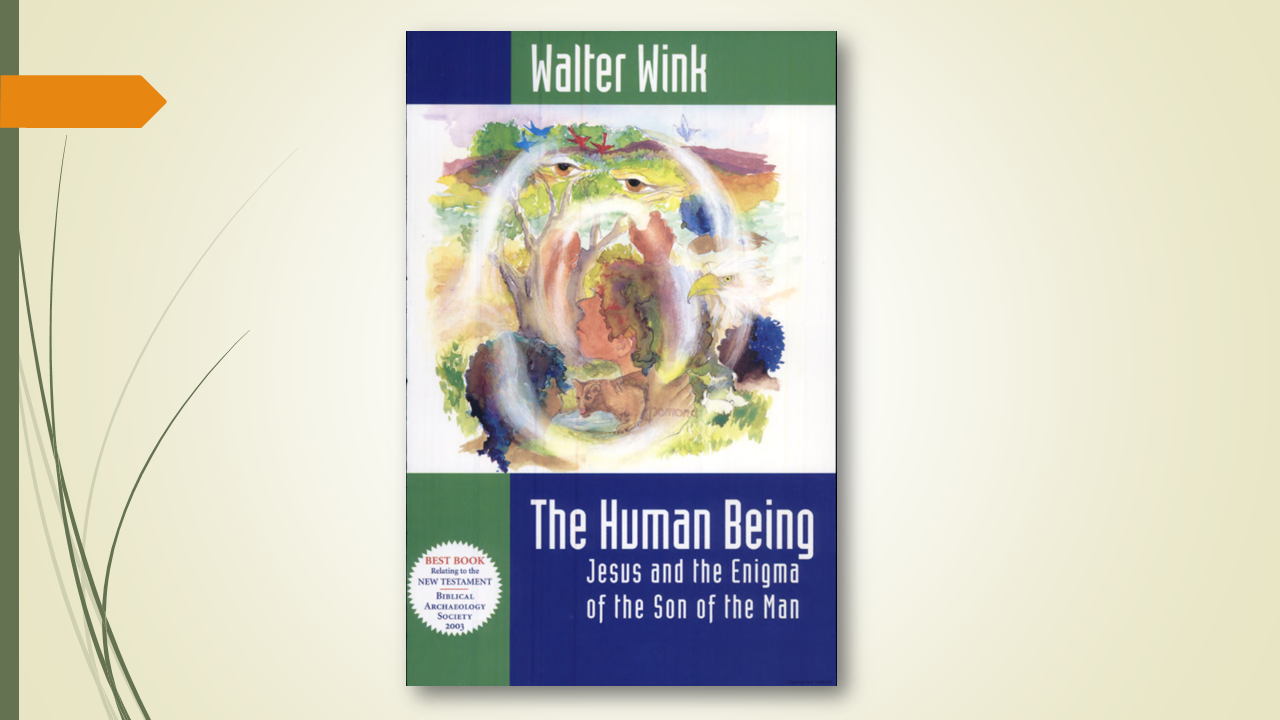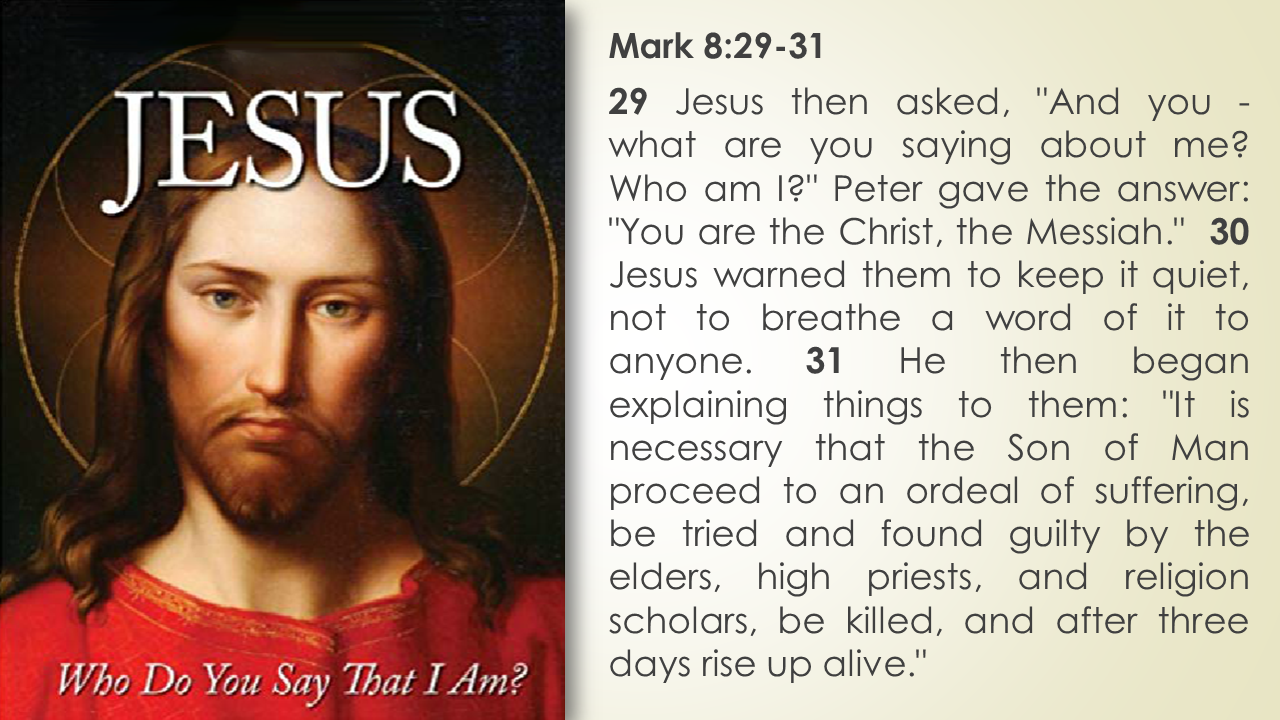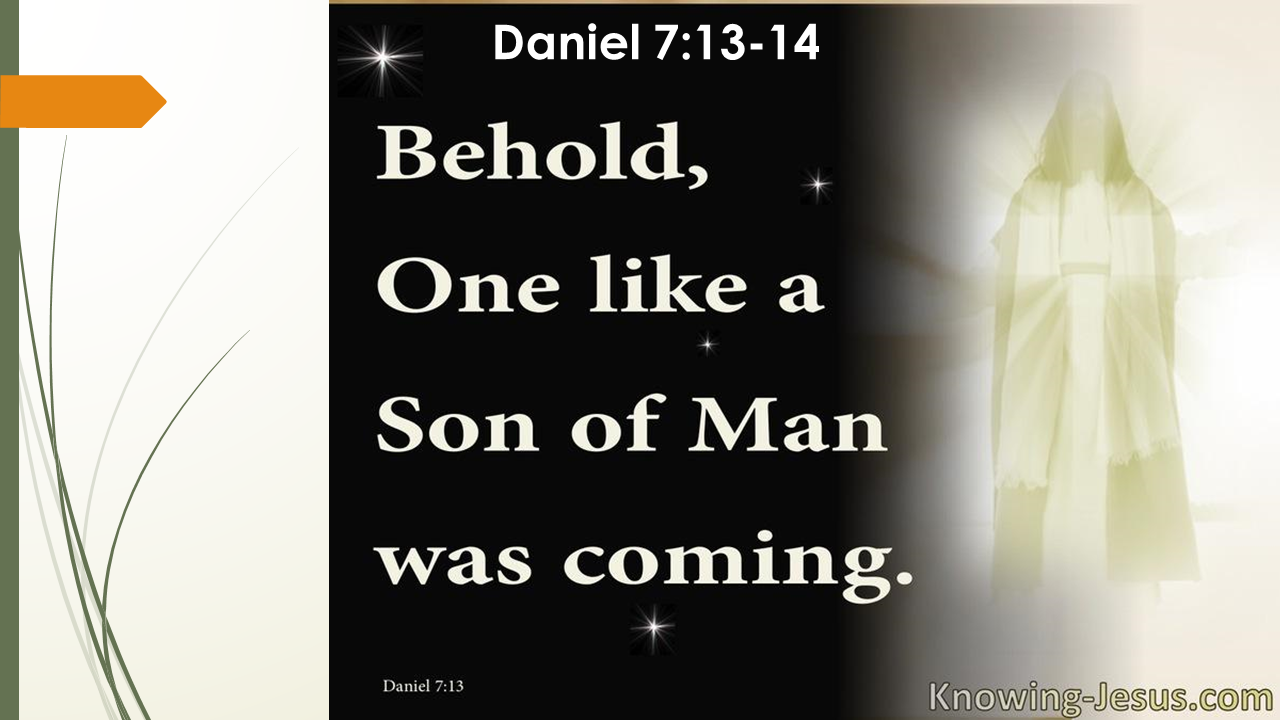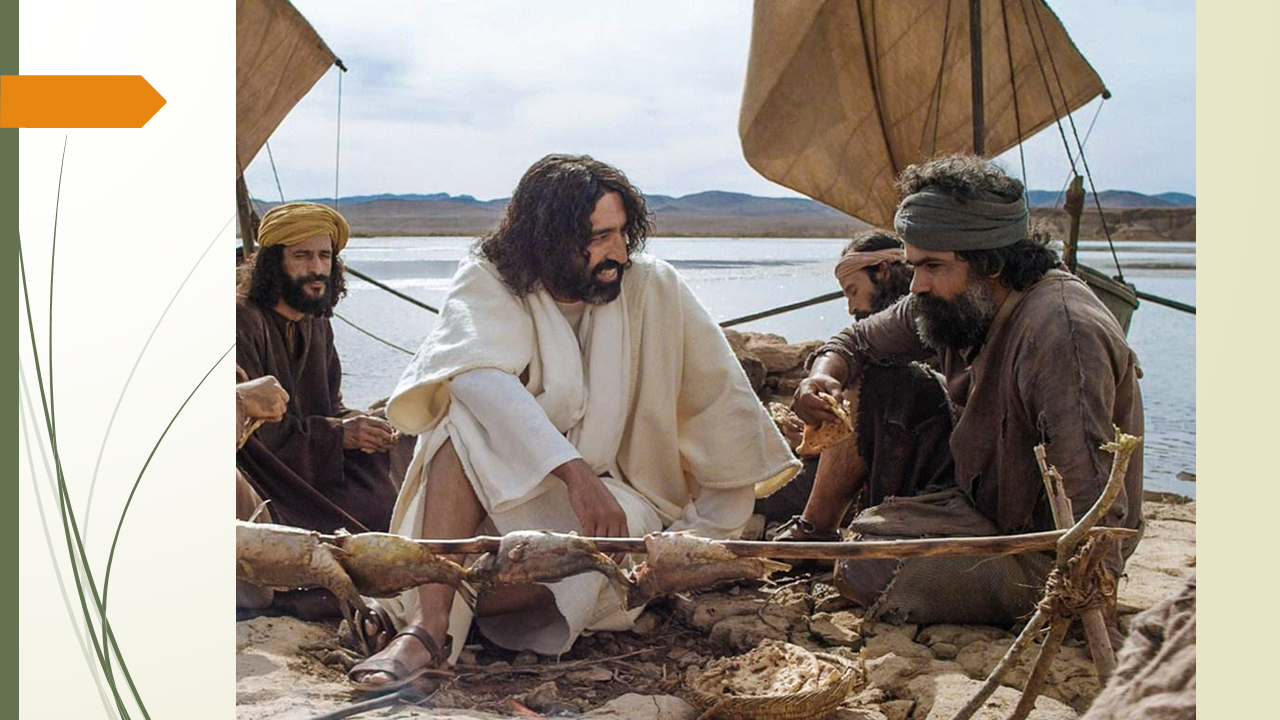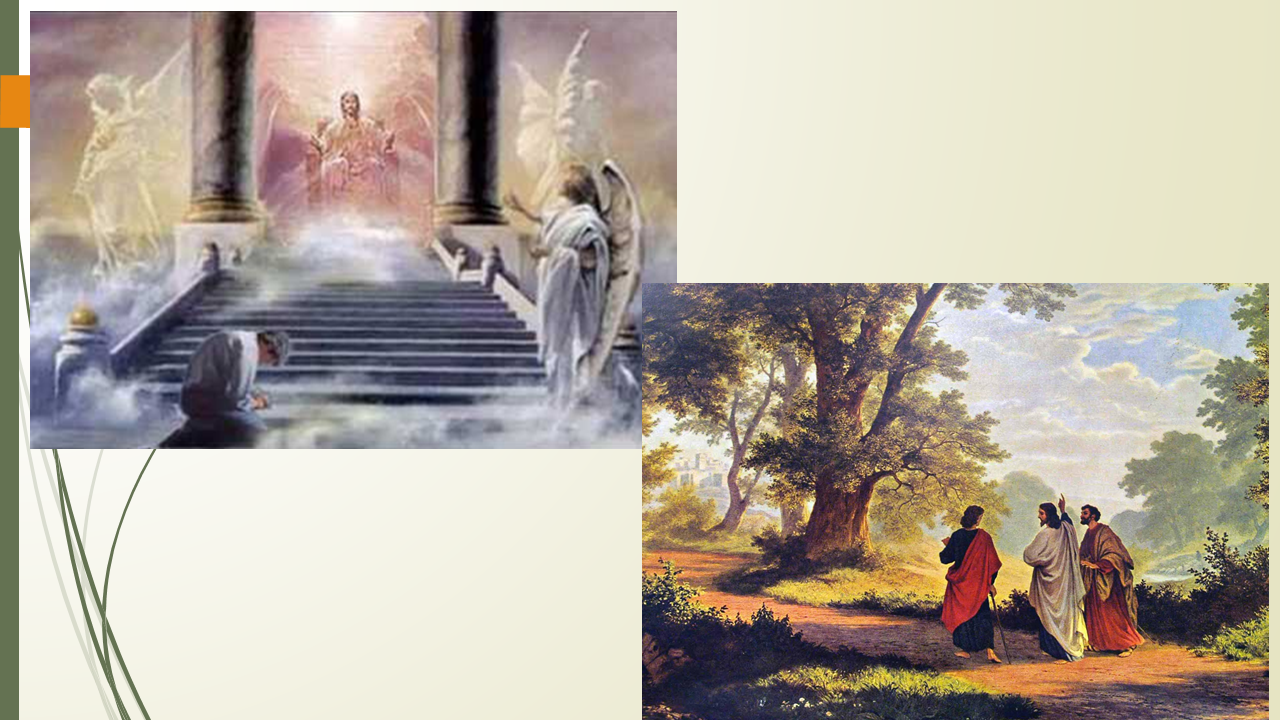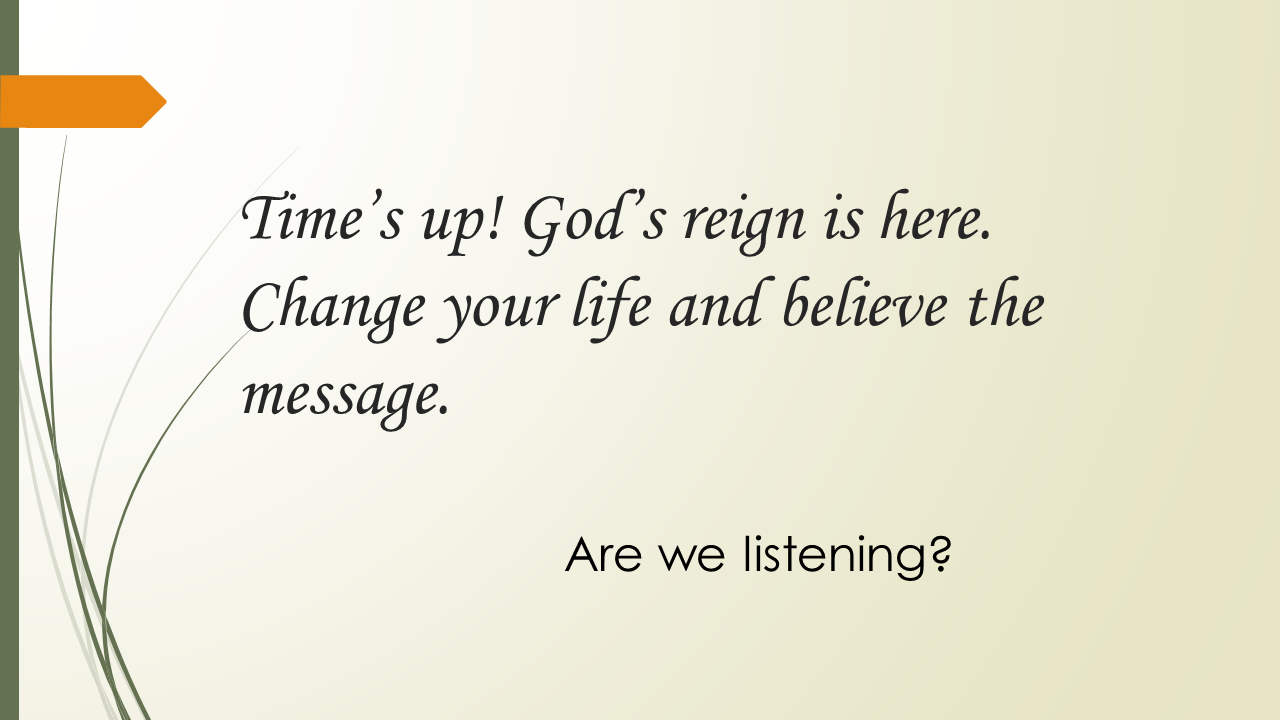Monte Vista Grove Homes Convocation on Jim's Ministry in New Zealand
30 Inquiries with Nico
| musings_-_jims_speech_2019.pptx | |
| File Size: | 6806 kb |
| File Type: | pptx |
This is our 19th gathering in this ongoing lecture series by Monte Vista Grove residents dealing with “Musings at the Juncture of Faith and Culture in the 21st Century.” After being the MC for most of these programs, several people said to me, “When are you going to speak?” Well, tonight is the night because I have become excited about a subject that I invite us all to “muse” about. As Gary Demarest said in our first lecture, a musing is becoming “absorbed in thought, especially to turn something over in the mind meditatively and often inconclusively”. Tonight I want to ‘muse’ about the signature statement of Jesus as he began his ministry in Galilee saying “Time’s up! God’s reign is here,” and how this might impact us here in the 21st Century.
I began thinking about this a year ago when Patty and I were visiting people I had known through a series of New Zealand ministries following my retirement. In Hawea on the South Island we enjoyed an afternoon and evening with Neal Brown, a retired Presbyterian minister, and his wife Allison. It was one of those electric conversations where we felt transported into a different zone of being. One thing we talked about was the lack of younger people in the church today both in New Zealand and the U.S. Instead of blaming Millennials for dropping out of the church and being selfish and anti-traditional, we thought maybe the problem was with the way the church presents the gospel message today. Maybe God is using Millennials to give the modern church a wake up call. What if we went back to the historical Jesus and looked at how he presented the message to people 2000 years ago? How did he excite them? inspire them? transform them? And if they could turn the world upside down 2000 years ago, why can’t we do it today? It was late before Patty and I left Neal and Allison that night, and Neal suggested a book to read, The Human Being by Walter Wink. I have been thinking about that conversation ever since, and I have been inspired by Wink’s book.
I began thinking about this a year ago when Patty and I were visiting people I had known through a series of New Zealand ministries following my retirement. In Hawea on the South Island we enjoyed an afternoon and evening with Neal Brown, a retired Presbyterian minister, and his wife Allison. It was one of those electric conversations where we felt transported into a different zone of being. One thing we talked about was the lack of younger people in the church today both in New Zealand and the U.S. Instead of blaming Millennials for dropping out of the church and being selfish and anti-traditional, we thought maybe the problem was with the way the church presents the gospel message today. Maybe God is using Millennials to give the modern church a wake up call. What if we went back to the historical Jesus and looked at how he presented the message to people 2000 years ago? How did he excite them? inspire them? transform them? And if they could turn the world upside down 2000 years ago, why can’t we do it today? It was late before Patty and I left Neal and Allison that night, and Neal suggested a book to read, The Human Being by Walter Wink. I have been thinking about that conversation ever since, and I have been inspired by Wink’s book.
So the situation we face today in the in the European and North American churches is that young people in general, and Millennials in particular, are voting to ignore or leave the church in droves. There are exceptions like Knox Presbyterian in Pasadena, but it is true for most mainline and evangelical churches. For those of us who are followers of Jesus that means in countries like New Zealand and the U.S., there is a whole generation of people who are largely ignoring Jesus. A recent Pew survey of 35000 Americans shows Christians have dropped from 78.4% to 70.6% of the U.S. population in the last 10 years. Over 1/3 of Millennials (age 22 to 38) claim no faith affiliation, up 10%. All you have to do is look at all the white hair of people in the pews on Sunday mornings to see the problem of fewer younger people. There are about 80 million Millennials, a significant part of the population.
Let’s look at how they see the church and how they see themselves.
How Millennials see the church How Millennials see themselves
being heavenly is good, church can choose how we live and
is a haven from the world what we make of it
salvation, inner focus in collaboration with others
fundamentally bad good and bad, and full of creativity
world and get up to God’s heaven ourselves and the world seeing
to be with Christ our King Jesus as a Godly guide
There is a real disconnect between the way many Millennials see themselves and the way they see the modern church. What can we learn from this? Let’s look at how Jesus engaged and invited people to follow him 2000 years ago.
In Mark, the first of the four gospels to be written, we read that Jesus began his ministry in Galilee with these words: “The time is fulfilled. The Kingdom of God is at hand. Repent and believe the Gospel.” That is the New Revised Standard Version translation. I like Eugene Peterson’s translation in The Message: “Time’s up! God’s kingdom is here. Change your life and believe the Message.” I remember my seminary teachers saying that this was the basic kerygma, the basic teaching of Jesus in just a few words. They also said that the word kingdom is misleading because it suggests a political entity with borders and armies. What Jesus was talking about was not a place or an event, but a state of being where we know who we are and we know God as our source of being. So instead of Kingdom I will use use the word “reign”, a verb that indicates God’s activity in our lives and in our world. So time is up because the promised reign of God in history, what we have been waiting for all these years, is HERE – and it is NOW – PRESENT TENSE. So REPENT - turn your life around – change your ways and believe this message. When Jesus came to those fishermen at the Sea of Galilee he was excited and they picked up on it. They sensed in Jesus that God’s reign was really here and they followed him.
If God’s reign is present in Jesus, it is important to know who Jesus is? What did he call himself? In the early church Jesus was called “ the son of God”, and “King”, and “Lord”, and “Messiah” (Hebrew) or “Christ” (Greek). But Jesus never referred to himself by any of these names. He called himself “the Son of Man”. It is recorded 68 times in the gospels and is the only designation he uses for himself. Joseph Kang has written widely about this title and notes that the term ‘man’ indicates gender in our English language, while the Greek word ‘anthropos’ means “human being” in general. So I will use the term “the Son of the Human Being”. Joe sees Jesus as the New Humanity which Jesus embodies in the reign of God.
- Judging the world 1. Engaging the world
being heavenly is good, church can choose how we live and
is a haven from the world what we make of it
- Focus on the individual 2. Focus on the community
salvation, inner focus in collaboration with others
- Human beings are sinful, lost 3. Humans are filled with potential
fundamentally bad good and bad, and full of creativity
- Vertical spirituality 4. Horizontal spirituality
world and get up to God’s heaven ourselves and the world seeing
to be with Christ our King Jesus as a Godly guide
There is a real disconnect between the way many Millennials see themselves and the way they see the modern church. What can we learn from this? Let’s look at how Jesus engaged and invited people to follow him 2000 years ago.
In Mark, the first of the four gospels to be written, we read that Jesus began his ministry in Galilee with these words: “The time is fulfilled. The Kingdom of God is at hand. Repent and believe the Gospel.” That is the New Revised Standard Version translation. I like Eugene Peterson’s translation in The Message: “Time’s up! God’s kingdom is here. Change your life and believe the Message.” I remember my seminary teachers saying that this was the basic kerygma, the basic teaching of Jesus in just a few words. They also said that the word kingdom is misleading because it suggests a political entity with borders and armies. What Jesus was talking about was not a place or an event, but a state of being where we know who we are and we know God as our source of being. So instead of Kingdom I will use use the word “reign”, a verb that indicates God’s activity in our lives and in our world. So time is up because the promised reign of God in history, what we have been waiting for all these years, is HERE – and it is NOW – PRESENT TENSE. So REPENT - turn your life around – change your ways and believe this message. When Jesus came to those fishermen at the Sea of Galilee he was excited and they picked up on it. They sensed in Jesus that God’s reign was really here and they followed him.
If God’s reign is present in Jesus, it is important to know who Jesus is? What did he call himself? In the early church Jesus was called “ the son of God”, and “King”, and “Lord”, and “Messiah” (Hebrew) or “Christ” (Greek). But Jesus never referred to himself by any of these names. He called himself “the Son of Man”. It is recorded 68 times in the gospels and is the only designation he uses for himself. Joseph Kang has written widely about this title and notes that the term ‘man’ indicates gender in our English language, while the Greek word ‘anthropos’ means “human being” in general. So I will use the term “the Son of the Human Being”. Joe sees Jesus as the New Humanity which Jesus embodies in the reign of God.
Let’s look at a passage where Jesus specifically spells out who he is and how he wants his followers to see him. In Mark 8:27 to 9:1 Jesus is at a turning point in his ministry and leads his disciples away from Galilee on the road to Caesarea Philippi. He asked, “Who do people say that I am?” They respond, “John the Baptist”, or “Elijah”, or “one of the prophets.” Jesus asked, “And you – what are you saying about me? Who am I?” Peter said, “You are the Christ, the Messiah.” Over the last 2000 years we are used to saying ‘Jesus Christ’ as if Christ were his last name. In fact, we often leave out the word “Jesus” and simply call him ‘Christ’. So we might expect Jesus to agree with Peter. But in Mark Jesus does just the opposite. He tells the disciples to keep it quiet and not breathe a word of it to anyone. Instead, he immediately talks to them about “the Son of the Human Being” who will go through an ordeal of suffering and trial and death and then rise up alive. Peter grabs Jesus in protest because he is still thinking about Jesus as the Messiah or Christ who will lead God’s troops to victory over God’s enemies, like the Roman soldiers who rule Palestine ruthlessly. Jesus sees his disciples wavering, wondering what to believe. So he says, “Peter, get out of my way. Satan, get lost. You have no idea how God works.”
Then Jesus calls to a crowd of followers, along with his disciples, and teaches them that they all need to follow him and engage the world by accepting suffering as something they all will share together. “Self-sacrifice is the way of God.” Jesus contrasts the popular idea of the Messiah who leads a conquering army to establish God’s kingdom by force to the way of the Son of the Human Being who establishes God’ reign through the power of self-sacrifice and suffering love. The word compassion means “to suffer with” others. Not domination but compassion is the way of Jesus. This passage ends with Jesus saying, “The Son of the Human Being will arrive in all the splendor of God, the Father, and some standing here will see the reign of God arrive in full force.”
Then Jesus calls to a crowd of followers, along with his disciples, and teaches them that they all need to follow him and engage the world by accepting suffering as something they all will share together. “Self-sacrifice is the way of God.” Jesus contrasts the popular idea of the Messiah who leads a conquering army to establish God’s kingdom by force to the way of the Son of the Human Being who establishes God’ reign through the power of self-sacrifice and suffering love. The word compassion means “to suffer with” others. Not domination but compassion is the way of Jesus. This passage ends with Jesus saying, “The Son of the Human Being will arrive in all the splendor of God, the Father, and some standing here will see the reign of God arrive in full force.”
In this passage Jesus expects his followers, his ‘millennials’, to do what he does as the Son of the Human Being. Could the Son of the Human Being be a collective figure, including not only Jesus but also his disciples… including those who follow Jesus in 2019? Mark 2:23-28 is one of many stories that say this. One day Jesus is walking through a grain field on the Sabbath and his disciples pull off heads of grain. The Pharisees complain to Jesus, “Look, your disciples are breaking Sabbath rules!” Keeping the Sabbath was the defining practice of Jews 2000 years ago, so Jesus and his disciples would have known that plucking grain was strictly forbidden by Jewish religious law. But Jesus reminds the Pharisees that when Abiather was High Priest David and his followers, when they were hungry, entered the sanctuary on the Sabbath and ate the Bread of the Presence – holy bread that only the priests were supposed to eat. Then Jesus said, “The Sabbath was made for humankind; not humankind for the Sabbath.” He is going back to the original meaning of the Sabbath in Genesis where God rests on the seventh day of creation, and all human beings are meant to rest on the seventh day based on our need to rest. So response to human need is the priority, not a religious rule. Then Jesus adds, “So the Son of the Human Being is lord even of the Sabbath.” Who is the Son of the Human Being here? The answer is those who plucked grain on the Sabbath, the disciples. Jesus want us to see that his followers are part of a communal Son of the Human Being, and they will carry on the work of God’s reign after he is no longer with them. They act in community.
At this point in my talk about Jesus as Messiah or Son of the Human Being, I can imagine some of you saying to yourself the two key words any speaker dreads – SO WHAT?
Who cares whether Jesus is Messiah or Son of the Human Being? I have two responses to the SO WHAT question, and they both have implications for 21st Century Christians and for open minded Millennials who might find new significance for their lives.
My first response to SO WHAT is that both ‘Messiah’ and ‘Son of the Human Being’ are apocalyptic figures. That is, they relate to our hopes and fears about the end time. In New Testament times in Palestine the brutal oppression of the people by Rome led them to wonder if they had any future at all. Today there is confusion and fear about the global threat of climate change, dysfunctional governments, the huge gap between rich and poor. Apocalyptic images respond to that confusion and fear with hope. You might say that in some ways the Messiah and the Son of the Human Being were to the First Century what Super Heroes like Batman and Spiderman are to the 21st Century.
My first response to SO WHAT is that both ‘Messiah’ and ‘Son of the Human Being’ are apocalyptic figures. That is, they relate to our hopes and fears about the end time. In New Testament times in Palestine the brutal oppression of the people by Rome led them to wonder if they had any future at all. Today there is confusion and fear about the global threat of climate change, dysfunctional governments, the huge gap between rich and poor. Apocalyptic images respond to that confusion and fear with hope. You might say that in some ways the Messiah and the Son of the Human Being were to the First Century what Super Heroes like Batman and Spiderman are to the 21st Century.
They save us from the forces of evil in a world go awry. Of course, the primary difference is that the Messiah and the Son of the Human Being are acting for God and God’s reign. Of these two images we are more familiar with the Messiah who will defeat the powers of evil militarily. Jesus rejects the violence and forced domination of a militant Messiah, but he identifies with the promise of a new age where God reigns. He chooses a different path, the way of the Son of the Human Being.
This is also an apocalyptic figure well known 2000 years ago in both Hebrew Scripture, mainly Daniel and Ezekiel, and non biblical sources. Daniel 7:13-14 says, “I saw a human form, a Son of the Human Being, arriving in a whirl of clouds. He was given power to rule. Everyone – race, color and creed – had to serve him. His rule would be forever.”
So Jesus claims to be this apocalyptic Son of the Human Being sent by God to rule all people. But is it really a future hope? Remember what Jesus said at the beginning of his ministry? “Time’s up! God’s reign is here.” This is present tense. In Mark 8 Jesus promised that God’s reign would come with power in the lifetime of the disciples. It happened in the resurrection and ascension. So Jesus says to his disciples and to us today, “Wake up! Look around.” The promised reign of the Son of the Human Being described by Daniel is already beginning, horizontally, in history. We are part of it here and now.
Another response to the “so what” question about Jesus as the Son of the Human Being is to see this concept as an archetype. Archetypes are innate, universal prototypes or patterns that are present in each of us. They can be called into our consciousness by stories or experiences that act as triggers. Jung saw key archetypes like the self or the shadow or the wise old man or the mother in each of us. A good writer connects with readers through relating to archetypes within the readers. The Harry Potter stories connected with millions of readers, young and old, through relating to archetypes within them.
Followers of Jesus find in him a pattern that resonates within them as an archetype. To me, this explains how an itinerant peasant preacher in First Century Palestine awakened in a huge number of people in a short time a movement that turned the world upside down. I believe that each of us has a Jesus archetype within us, a pattern that becomes conscious when we accept Jesus as our personal leader and guide. It is personal and unique to each of us, and yet the pattern can tie us together in community. It is what happened to Jesus and his disciples when they came together as the Son of the Human Being. Here is how I have experienced the Jesus archetype.
In 1974 I was the organizing pastor of an alternative church in Olympia, Washington. We focused on being a true community and called ourselves the Community for Christian Celebration. I felt good about the free-wheeling worship and our involvement in social justice. But many members were dealing with deep personal and spiritual issues that were overwhelming to me. I felt inadequate. A friend suggested getting training in psycho-synthesis, a discipline that combined spiritual and psychological responses to people based on the work of Carl Jung.
Another response to the “so what” question about Jesus as the Son of the Human Being is to see this concept as an archetype. Archetypes are innate, universal prototypes or patterns that are present in each of us. They can be called into our consciousness by stories or experiences that act as triggers. Jung saw key archetypes like the self or the shadow or the wise old man or the mother in each of us. A good writer connects with readers through relating to archetypes within the readers. The Harry Potter stories connected with millions of readers, young and old, through relating to archetypes within them.
Followers of Jesus find in him a pattern that resonates within them as an archetype. To me, this explains how an itinerant peasant preacher in First Century Palestine awakened in a huge number of people in a short time a movement that turned the world upside down. I believe that each of us has a Jesus archetype within us, a pattern that becomes conscious when we accept Jesus as our personal leader and guide. It is personal and unique to each of us, and yet the pattern can tie us together in community. It is what happened to Jesus and his disciples when they came together as the Son of the Human Being. Here is how I have experienced the Jesus archetype.
In 1974 I was the organizing pastor of an alternative church in Olympia, Washington. We focused on being a true community and called ourselves the Community for Christian Celebration. I felt good about the free-wheeling worship and our involvement in social justice. But many members were dealing with deep personal and spiritual issues that were overwhelming to me. I felt inadequate. A friend suggested getting training in psycho-synthesis, a discipline that combined spiritual and psychological responses to people based on the work of Carl Jung.
On my fortieth birthday – read mid-life crisis here - I showed up for a three week training in psycho-synthesis on the Stanford Campus. A key element in the training was a series of guided meditations. For the first five days I was lost – when the leaders would ask us to close our eyes and imagine ourselves in a mountain meadow or a cave, I could see nothing but circlers or squares, or I would fall asleep. We were asked to begin each morning with a time of silent meditation that would allow any image to come to us, and to follow wherever the spirit lead. Here is what I saw on day six.
A mysterious, hooded figure was coming toward me. His face was in shadows – I saw only his eyes. He motioned for me to follow him. I was scared and thought of opening my eyes, but immediately thought that since this was the first time I had seen anything during the meditations I better stick with it. My hooded guide led me to a large lake at sunset. By the shore I saw a strange rowboat that had red, neon lights shining from the gunnels, hull and keel. My guide climbed into the boat and motioned for me to follow. As soon as I got into it, the boat took off, not into the nearby lake but up into the sky. We were zooming along and the wind blew the hood back from my guide’s head. His hair and beard were a mix of black and white, like salt and pepper. His grey eyes were sparkling, and he laughed at the excitement of the wild ride. I asked him, “Are you Jesus?” He immediately replied, “Yes, of course I am,” and I caught a twinkle in his eyes. Then I saw we were headed into a cloud, and I sensed that this ride would soon be over. I said to Jesus, “I feel overwhelmed. What is this all about?” He replied, “This is about my being present to you every day of your life. Whenever you feel lost or unsure of yourself, I am with you to give support and love. Count on it.”
I went back to the psycho-synthesis guided meditations and saw every image that was suggested. When I went home I began conducting workshops using the techniques I learned, and my total ministry was changed. Three different summers at Ghost Ranch I joined with a Trappist Monk to teach week long seminars on Personal Spiritual Integration using psycho-synthesis. Most important to me is the sense that ever since this experience I have known that Jesus is the presence of God in my life and I no longer feel inadequate - no longer alone. I also sense that this presence is shared with others in the present reign of God. What Jesus said is true for me: “Time’s up! God’s reign is here.” I truly believe that we today are being given a gift of this archetype of Jesus as the Son of the Human Being and that it can motivate us to reach out to people today.
So let’s think about the list of how Millennials, as well as many others, see the church and how they see themselves in the light of what we have said about Jesus as the Son of the Human Being. The first statement was that Millennials see the church as judging an evil world and judging them. Instead, they feel the world is neutral, what we make of it, so they want to engage the world and make it a better place. This what the Son of the Human Being did, he engaged the world, he engaged people instead of judging them. Maybe Millennials are God’s way of challenging the church to engage the world today.
Here is an example. After my retirement in 1999 I was privileged to serve short term ministries in eight different New Zealand Presbyterian churches. In a culture that is much more secular than the United States, I felt these churches were too withdrawn from their communities, giving the impression that they were havens of retreat where people could escape the evils of the world. Working with the sessions in each of these churches we arranged with a local pub or coffee house to have a lecture series on issues of interest to both church members and the wider non-church community. We did a good job of advertising and people showed up in numbers far surpassing my expectations, about an equal number of church and wider community people. In lively conversations the church was definitely engaging the world, one way of expressing God’s reign with empathy and compassion for all.
A second concern of Millennials and others today is that the church seems to be primarily concerned with personal salvation, an individual focus, while they want to work out their challenges in collaboration with others, a community focus. We have seen that the Son of the Human Being is not only Jesus by himself, but Jesus with his followers both 2000 years ago and today. Personal, individual salvation is part of the Christian experience, but we also need to pay attention to the way we experience God’s reign in compassionate community.
If we want an example of God’s present reign in the world today, all we have to do is look around us here at Monte Vista Grove.
A mysterious, hooded figure was coming toward me. His face was in shadows – I saw only his eyes. He motioned for me to follow him. I was scared and thought of opening my eyes, but immediately thought that since this was the first time I had seen anything during the meditations I better stick with it. My hooded guide led me to a large lake at sunset. By the shore I saw a strange rowboat that had red, neon lights shining from the gunnels, hull and keel. My guide climbed into the boat and motioned for me to follow. As soon as I got into it, the boat took off, not into the nearby lake but up into the sky. We were zooming along and the wind blew the hood back from my guide’s head. His hair and beard were a mix of black and white, like salt and pepper. His grey eyes were sparkling, and he laughed at the excitement of the wild ride. I asked him, “Are you Jesus?” He immediately replied, “Yes, of course I am,” and I caught a twinkle in his eyes. Then I saw we were headed into a cloud, and I sensed that this ride would soon be over. I said to Jesus, “I feel overwhelmed. What is this all about?” He replied, “This is about my being present to you every day of your life. Whenever you feel lost or unsure of yourself, I am with you to give support and love. Count on it.”
I went back to the psycho-synthesis guided meditations and saw every image that was suggested. When I went home I began conducting workshops using the techniques I learned, and my total ministry was changed. Three different summers at Ghost Ranch I joined with a Trappist Monk to teach week long seminars on Personal Spiritual Integration using psycho-synthesis. Most important to me is the sense that ever since this experience I have known that Jesus is the presence of God in my life and I no longer feel inadequate - no longer alone. I also sense that this presence is shared with others in the present reign of God. What Jesus said is true for me: “Time’s up! God’s reign is here.” I truly believe that we today are being given a gift of this archetype of Jesus as the Son of the Human Being and that it can motivate us to reach out to people today.
So let’s think about the list of how Millennials, as well as many others, see the church and how they see themselves in the light of what we have said about Jesus as the Son of the Human Being. The first statement was that Millennials see the church as judging an evil world and judging them. Instead, they feel the world is neutral, what we make of it, so they want to engage the world and make it a better place. This what the Son of the Human Being did, he engaged the world, he engaged people instead of judging them. Maybe Millennials are God’s way of challenging the church to engage the world today.
Here is an example. After my retirement in 1999 I was privileged to serve short term ministries in eight different New Zealand Presbyterian churches. In a culture that is much more secular than the United States, I felt these churches were too withdrawn from their communities, giving the impression that they were havens of retreat where people could escape the evils of the world. Working with the sessions in each of these churches we arranged with a local pub or coffee house to have a lecture series on issues of interest to both church members and the wider non-church community. We did a good job of advertising and people showed up in numbers far surpassing my expectations, about an equal number of church and wider community people. In lively conversations the church was definitely engaging the world, one way of expressing God’s reign with empathy and compassion for all.
A second concern of Millennials and others today is that the church seems to be primarily concerned with personal salvation, an individual focus, while they want to work out their challenges in collaboration with others, a community focus. We have seen that the Son of the Human Being is not only Jesus by himself, but Jesus with his followers both 2000 years ago and today. Personal, individual salvation is part of the Christian experience, but we also need to pay attention to the way we experience God’s reign in compassionate community.
If we want an example of God’s present reign in the world today, all we have to do is look around us here at Monte Vista Grove.
Two and one half years ago my wife Marilyn began a slide that included physical difficulty walking and several falls, a lack of desire for food, and no interest in conversation except to answer questions with a “Yes” or “No.” Residents and staff here could see what was happening, and treated both of us with compassion and respect. Marilyn was in Hospice care at the Health Center for six days. I was amazed at the level of concern and caring by the Hospice nurse and chaplain, the Health Center staff, Rev. Zelda Kennedy from our church, and numerous residents who came by to offer love and prayers. This is what the reign of God is all about, living in compassionate community, whether it is Jesus with his followers 2000 years ago, or you and me here at Monte Vista Grove today. I believe Millennials and all people are looking for this kind of engagement, this kind community.
Another insight from Millennials is that they see Christians focusing on sin as a primary human condition, while they would see humans as vulnerable, both good and bad, but filled with human potential. Jesus saw all humans as sinners, but he did not focus on sin as our primary condition. Instead, he always looked for ways his followers could fulfill their human potential. This began with the first invitation to those fishermen by the Sea of Galilee in the first chapter of Mark.
As far as we know, Peter, Andrew, James and John only saw themselves as good at catching fish. Jesus sees something in them they do not see in themselves. He invites them to follow him and they will be able to catch people. Their lives unfold in amazing ways because Jesus sees the potential in each of them, and he invites them to join him as the Son of the Human Being establishing God’s reign in all the earth. At one point Jesus says, “The Reign of God is within you.” Just as God’s reign is being established in the world over time, so God’s reign within us is enabling us to grow and change through our lifetimes. Jesus helps us fulfill our potential as human beings.
In the Community for Christian Celebration our congregation was primarily Millennials, young families. We focused on faith as a process, looking at how we pass through transitions and stages as we grow in our faith. We created a manual of activities and study groups that help people keep growing in their faith. My experience with psycho-synthesis was a major step in faith development for me and in our community. I see Jesus guiding his disciples through a process of faith development in the Caesarea Philippi story where he invites them to join him as the Son of the Human Being who will establish God’s reign through suffering love. If Millennials and each of us could see faith as an unfolding process where God helps us fulfill our potential or become more human they will get excited about the movement Jesus initiated.
Perhaps the most difficult thing for Millennials to accept about the current church as they see it is the idea that ultimate meaning is to leave the world and get to heaven, a vertical ascent. These young people find ultimate meaning in transforming the world, using their personal potential and creativity, a horizontal movement. In fact, the whole meaning of the Son of the Human Being is that, as Daniel describes it, he comes in a whirl of clouds and is given power to rule here on earth.
I believe this is happening in the present, horizontally, in this world. I perceive God’s reign explicitly in Jesus, the Son of the Human Being, and implicitly wherever suffering love confronts worldly power, hatred and violence.
In the Community for Christian Celebration our congregation was primarily Millennials, young families. We focused on faith as a process, looking at how we pass through transitions and stages as we grow in our faith. We created a manual of activities and study groups that help people keep growing in their faith. My experience with psycho-synthesis was a major step in faith development for me and in our community. I see Jesus guiding his disciples through a process of faith development in the Caesarea Philippi story where he invites them to join him as the Son of the Human Being who will establish God’s reign through suffering love. If Millennials and each of us could see faith as an unfolding process where God helps us fulfill our potential or become more human they will get excited about the movement Jesus initiated.
Perhaps the most difficult thing for Millennials to accept about the current church as they see it is the idea that ultimate meaning is to leave the world and get to heaven, a vertical ascent. These young people find ultimate meaning in transforming the world, using their personal potential and creativity, a horizontal movement. In fact, the whole meaning of the Son of the Human Being is that, as Daniel describes it, he comes in a whirl of clouds and is given power to rule here on earth.
I believe this is happening in the present, horizontally, in this world. I perceive God’s reign explicitly in Jesus, the Son of the Human Being, and implicitly wherever suffering love confronts worldly power, hatred and violence.
I see it in Dr. Martin Luther King’s movement to change America through non-violent action. It is in Mother Theresa' care for the dying on the streets of Calcutta. I see God’s reign wherever compassion confronts domination, with Archbishop Desmond Tutu and Nelson Mandela in South Africa, or Gandhi in India and the Dalai Lama. It is Malala inspiring young women in Pakistan and around the world.
Here at the Grove in many of our recent Convocation programs we see God’s reign horizontally in the world today. Some of us will remember David Eubanks, a missionary who came to Mosul in the middle of the fighting with Isis two years ago and braved bullets to save innocent civilians in the midst of battle. That’s God’s reign. Or Ralph Hamburger who described his amazing ministry behind the iron curtain after World War II - God’s reign in Europe. Or just this last fall, we learned from Megan Katerjian about the Door of Hope here in Pasadena, a Christian agency that has an over 80% success rate in helping homeless families become independent. Two weeks later Janet Wells and Marilyn Manning told about the Ministry of Hope in Malawi, working with some of the poorest people on our planet to help them overcome difficult challenges and find fulfilling lives.
This is God’s reign in our world today. They describe God at work in the lives of followers of Jesus who are carrying out the mission of the Son of the Human Being. I think Millennials are not so interested in God who rules on high apart from the earth, or Jesus the king who dominates the world from a heavenly throne.
Here at the Grove in many of our recent Convocation programs we see God’s reign horizontally in the world today. Some of us will remember David Eubanks, a missionary who came to Mosul in the middle of the fighting with Isis two years ago and braved bullets to save innocent civilians in the midst of battle. That’s God’s reign. Or Ralph Hamburger who described his amazing ministry behind the iron curtain after World War II - God’s reign in Europe. Or just this last fall, we learned from Megan Katerjian about the Door of Hope here in Pasadena, a Christian agency that has an over 80% success rate in helping homeless families become independent. Two weeks later Janet Wells and Marilyn Manning told about the Ministry of Hope in Malawi, working with some of the poorest people on our planet to help them overcome difficult challenges and find fulfilling lives.
This is God’s reign in our world today. They describe God at work in the lives of followers of Jesus who are carrying out the mission of the Son of the Human Being. I think Millennials are not so interested in God who rules on high apart from the earth, or Jesus the king who dominates the world from a heavenly throne.
They are far more likely to follow Jesus, the Son of the Human Being, who embodies the New Humanity and is transforming the world today. He is walking alongside us.
I am musing. I wonder if we are listening to Jesus. “Time’s up! God’s reign is here. Change your life and believe the message.” I wonder if we are listening to the questions raised by Millennials which may be questions raised by God for all of us. I wonder if we are truly engaging God’s reign within each of us…within the world…right here…right now. Time’s up!
I am musing. I wonder if we are listening to Jesus. “Time’s up! God’s reign is here. Change your life and believe the message.” I wonder if we are listening to the questions raised by Millennials which may be questions raised by God for all of us. I wonder if we are truly engaging God’s reign within each of us…within the world…right here…right now. Time’s up!
